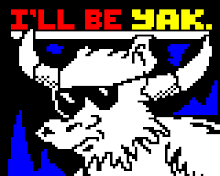Intro - Technical/history
- Teletext's invention and inception (1970).
- Background: other digital media around at the time: arcade video games, links in commercial popularity and aesthetic. 1972 - Pong becomes widely popular, 1976 - teletext launched. ARPAnet in America - primitive early version of the Internet. Functionalities.
- Aesthetic. 1974: the 40x24 character grid was agreed upon, including text and a few graphic characters for creating simple graphics. The constituent media of 'teletext' - Teletext and Viewdata.
- Teletext's growth in popularity
- 1990s - firmly in public conscience.
- Teletext and television.
- Television sketch parodies - Alexei Sayle.
- Pages from Ceefax.
- Case study: Tom Moody's 'Dallas' project (1990). Teletext as an extension of television, a text version of the medium. Comments on television and society
- 1997 - teletext spreads to satellite. Small case study - Data Design commercial teletext design - MTV teletext.
- Pioneering: the medium's status as first commercially successful digital information retrieval method. Bringing technology to the masses through limited set of aesthetic restrictions.
- Teletext's service - uses. Simple games. Information service. Accessibility tool - subtitling.
- Case study: functions as compared to (early) Internet - Viewdata's crude email system; reader view pages - use of teletext pages as discussion forums etc. How the two mediums never genuinely converged.
- Internet growth in popularity (1990s).
- For the 1990s, coexisted with teletext.
- 2000s: Internet begins to take over.
- Teletext adapted for the web browser.
- Jodi's 'text' piece.
- Carola Unterberger-Probst: 'Framed'
- Encoding to receive analogue teletext via net.
- Teletext's expansion worldwide (1980s)
- Ceefax grows from 30 pages in 1973 to 600 in mid-80s. Spread to France, America in early 80s.
- Along with Atari home console, propagating the 'jagged pixellation' aesthetic. Paul Slocum: Atari > windowed GUI.
- From first analogue aerial switch off in 2007 to the complete switch off in 2012.
- Differing public opinions - "sad to see it go", "natural progression of technology would see it die out".
- Introduction of digital TTX and later Interactive TV - an evolved form of the traditional analogue version. 'Sounding death knoll' of the traditional aesthetic.
- Level 1 and 2 teletext upgrades - how these relate to modern 'digital teletext' in terms of aesthetic. The 'stepping stone' between teletext and digital teletext.
- It would seem the traditional format is doomed but the very medium which could see it die out would be the one allowing it to live on after the analogue switch off, namely the Internet.
- Estonia - still the No.1 method of information retrieval ahead of the Internet. Tarmo Tanilsoo's tribute websites.
- Case study: Lektrolab - 2006 Microtel project. People still using teletext aesthetic to create art.
- Despite sharing a number of functions, Teletext is not really the predecessor of the Internet, more a separately evolved medium with some similarities. Whereas the ARPA network developed in America teletext was more a British invention and, even though there were signs they might with Viewdata, at no point did the two converge.
- Maybe a simple diagram showing the two separate 'evolutions' could explain this point.
- The teletext aesthetic survives?
- Later, the Internet allowed for enthusiasts to create homages to the medium. To date, there are over 500 worldwide terrestrial teletext services available on the Internet. This could be the medium that sees the aesthetic live on, even after the analogue version is gone.
- The mobile web browser as having similar technical/aesthetic restrictions.
- Lektrolab's project shows there are still those who value the aesthetic as a medium for artistic expression. Eboy shows that the pixel as an aesthetic is still in the public's conscience in the fact it still has commercial value (brief mention of Eboy, not worth going into great detail over).
- Services such as Digitiser, even after they were taken from terrestrial screens, adapted to the online format (Digiworld). Fan sites.
Cross reference sections in some way.


0 comments:
Post a Comment